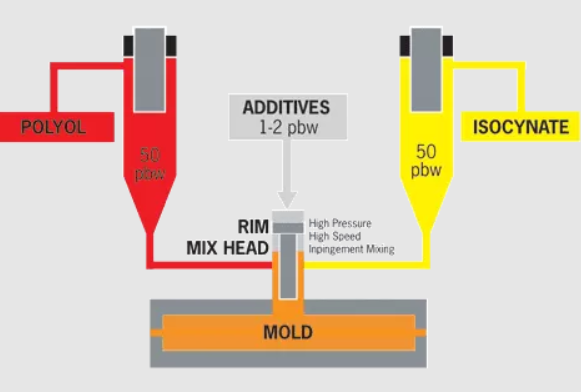
Reaction Injection Molding (RIM) is a manufacturing process used to produce molded plastic parts by mixing two or more liquid reactants and injecting them into a mold where they chemically react and cure. Unlike traditional injection molding, which melts and injects thermoplastic polymers, RIM involves the injection of thermosetting polymers that undergo a chemical reaction to form the final product.
Key Components and Process
1. Raw Materials
RIM typically uses liquid polymers such as polyurethanes, polyureas, or epoxy resins. These materials consist of two main components:
- Polyol: A type of alcohol with multiple hydroxyl groups, which acts as a reactant.
- Isocyanate: A reactive compound that reacts with the polyol to form a polymer.
2. Mixing
The raw materials are stored in separate tanks and are precisely metered and mixed together just before injection. This mixing initiates a chemical reaction between the polyol and isocyanate, leading to polymerization.
3. Injection
The mixed reactants are injected into a mold at low pressure. The mold is typically made of aluminum or steel and can be designed with complex geometries.
4. Chemical Reaction and Curing
Inside the mold, the chemical reaction continues, and the mixture starts to expand and solidify. The curing process can be relatively quick, depending on the materials and part design.
5. Demolding
Once the part is fully cured, it is removed from the mold. The mold can then be prepared for the next cycle.
Advantages of Reaction Injection Molding
1. Low Pressure Process
RIM operates at much lower pressures compared to traditional injection molding, reducing the cost of the mold and equipment and allowing the production of large and complex parts.
2. Material Properties
RIM produces parts with excellent mechanical properties, such as high impact resistance, flexibility, and durability. The resulting parts can also be lightweight with a high strength-to-weight ratio.
3. Design Flexibility
RIM allows for the creation of complex shapes and intricate details, making it ideal for producing parts with varying wall thicknesses and intricate geometries.
4. Cost Efficiency
The lower pressure and temperature requirements reduce energy consumption and equipment wear, leading to lower overall production costs. Additionally, RIM molds are generally less expensive to produce and maintain.
[elementor-template id=”4330″]
Applications of Reaction Injection Molding
1. Automotive Industry
RIM is widely used in the automotive industry to produce large parts such as bumpers, fenders, and dashboards. The process allows for lightweight yet durable components that contribute to fuel efficiency and safety.
2. Medical Equipment
Medical device manufacturers use RIM to produce housings, enclosures, and ergonomic components. The ability to produce complex shapes and the biocompatibility of certain RIM materials are advantageous in this sector.
3. Industrial Equipment
RIM is used to create durable and impact-resistant parts for industrial machinery and equipment, including housings, panels, and protective covers.
4. Consumer Products
Various consumer products, such as sporting goods, furniture, and electronic housings, benefit from the versatility and durability provided by RIM.
Differences Between RIM and Traditional Injection Molding
1. Material Types
- RIM: Uses thermosetting polymers that chemically react and cure.
- Traditional Injection Molding: Uses thermoplastic polymers that are melted and then solidified.
2. Pressure and Temperature
- RIM: Operates at lower pressures and temperatures, making it suitable for large parts and reducing equipment costs.
- Traditional Injection Molding: Requires higher pressures and temperatures, which can limit the size and complexity of parts.
3. Cycle Time
- RIM: Generally has longer cycle times due to the chemical curing process.
- Traditional Injection Molding: Typically has shorter cycle times due to the rapid cooling and solidification of thermoplastics.
4. Part Characteristics
- RIM: Produces parts with a high strength-to-weight ratio, excellent impact resistance, and the ability to form complex geometries.
- Traditional Injection Molding: Produces parts with high precision and is suitable for mass production of smaller, more detailed parts.
[elementor-template id=”4331″]
Practical Example
Consider the production of a polyurethane car bumper:
Material Selection
A polyurethane system is chosen for its toughness and flexibility.
Mold Design
The mold is designed with intricate details to include mounting points and aesthetic features. It is made from aluminum to accommodate the low-pressure RIM process.
Process Optimization
The polyol and isocyanate are precisely mixed and injected into the mold. The chemical reaction begins immediately, causing the material to expand and fill the mold.
Quality Control
The part is inspected for uniformity, absence of air bubbles, and adherence to mechanical specifications. Any necessary adjustments are made to the process parameters to ensure high-quality production.
Conclusion
Reaction Injection Molding is a versatile and cost-effective process for producing large, complex, and durable parts. Its unique advantages, such as low-pressure operation, material flexibility, and design freedom, make it suitable for various industries, including automotive, medical, industrial, and consumer products. By understanding the principles and benefits of RIM, manufacturers can leverage this technology to produce high-quality parts that meet the demanding requirements of today’s markets.
Related Conten: https://www.m-dtg.com/service/plastic-blow-molding/
 DTG Mould Trade Process |
|
| Quote: | According to sample, drawing and specific requirement. |
|---|---|
| Discussion | Mold material, cavity number, price, runner, payment, etc. |
| S/C Signature | Approval for all the items. |
| Advance | Pay 50% by T/T |
| Product Design Checking | We check the product design. If some position is not perfect, or can not be done on the mould, we will send customer the report. |
| Mold Processing | Send report to customer once each week |
| Mold Testing | Send trial samples and try-out report to customer for confirmation |
| Mold Modification | According to customer’s feedback. |
| Balance Settlement | 50% by T/T after the customer approved the trial sample and mould quality. |
| Delivery | Delivery by sea or air. The forwarder can be designated by your side. |
 |
|

